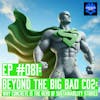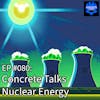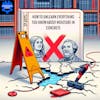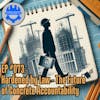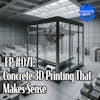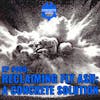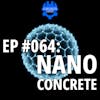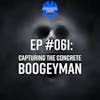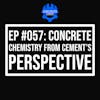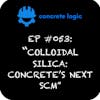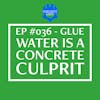EP #068: Banking on a Greener Concrete
In this episode of the Concrete Logic Podcast, Seth interviews Jason Adams from Megaslab, a technology company focused on optimizing concrete design and reducing material usage. They discuss the concept of jointless slabs and how Megaslab has evolved to offer a range of unique features.
Jason highlights the industry's commitment to sustainability and reducing embodied carbon in concrete. They also explore the challenges and misconceptions in the industry and the need for innovation in concrete testing. Jason shares his vision for the future, including plans to monetize carbon reduction and offers an opportunity to the listeners.
Takeaways
- An overall view on optimizing concrete design and reducing material usage.
- The industry's commitment to sustainability and reducing embodied carbon in concrete.
- There is a need for innovation in concrete testing to better assess durability and wear resistance.
- Megaslab aims to monetize carbon reduction and create a marketplace for low-carbon concrete certificates or credits.
Chapters
00:00 Introduction and Catching Up with Jason Adams
02:03 A Technology Company for Concrete
05:44 Optimizing Concrete Design and Reducing Material Usage
06:46 Working with Authorized Installers and Unique Projects
08:41 Sustainability and Embodied Carbon Reduction
12:47 Life Cycle Analysis and Longevity of Megaslab
15:31 Challenges and Misunderstandings in the Concrete Industry
18:25 Carbon Reduction and Monetization
20:19 The Future of Cement and Concrete Testing
25:16 The Importance of Durability and Wear Resistance
28:59 Innovation and the Future of Concrete Testing
31:36 Expanding Megaslab and Carbon Reduction Initiatives
34:36 Contact Information and Closing Remarks
***
Did you learn something from this episode? If so, please consider donating to the show to help us continue to provide high-quality content for the concrete industry.
Donate here: https://www.concretelogicpodcast.com/support/
***
Episode References
Guest: Jason Adams | Megaslab | info@megaslab.com Guest Website: https://megaslab.com/
Producers: Jodi Tandett, Jace Stocker
Donate & Become a Producer: https://www.concretelogicpodcast.com/support/
Music: Mike Dunton | https://www.mikeduntonmusic.com | mikeduntonmusic@gmail.com | Instagram @Mike_Dunton
Host: Seth Tandett, seth@concretelogicpodcast.com
Host LinkedIn: https://www.linkedin.com/in/seth-tandett/
Website: https://www.concretelogicpodcast.com/
LinkedIn: https://www.linkedin.com/company/concrete-logic-podcast
[00:00:00] Seth: And welcome to another episode of the Concrete Logic podcast. And today I have Jason Adams with Megaslab. When I say Megaslab, I feel like I should have like an echo, Megaslab, something like that.
[00:00:12] Jason Adams: Yes.
[00:00:12] Seth: Jason was on episode four. We just recently released 67.
[00:00:17] it's been a long time since we talked to Jason. So we're going to get caught up with Jason on what he's doing. But before we get started, I just want to remind everybody the deal with the podcast is a value for value podcast. meaning if you get some value out of this podcast today, if Jason shares something with you today that you did not know, there's three different ways you can help the podcast out.
[00:00:37] One is share the podcast with somebody that you know, that would get value out of this. The second thing you can do is if you visit our website, there's several ways you can get ahold of me. But one of the ways is in the bottom right hand corner, there's a microphone button. If you click on that microphone, you can record a voicemail, and that voicemail will come to me, and you can either say how much you like the podcast, or you can give me an idea for a podcast, or a topic, that would be fantastic.
[00:01:07] Or anything else you want to leave me. You could tell me how terrible the podcast is. I just want to hear from everybody. That would be great. And then the last way is a donation. So you can, on the upper right hand corner of the website, there's a donation button. If you click on that, it’ll allow you to donate any amount you want, and any amount is appreciated.
[00:01:26] It doesn't matter what it is. Whatever value you get out of the podcast, is fine. Jason with that, let's get rolling into this. So Mega Slab. I was going to say jointless slab and you stopped me. What are we doing?
[00:01:40] Jason Adams: Well, thank you for having me on Seth first and foremost.
[00:01:43] I really value it. You're doing for the industry, the folks that you brought on to your show the knowledge base is incredible, and I think we're all striving to make the industry better. I certainly love the concrete industry. Yeah, I stopped you in the whole joint list thing because that's for us now.
[00:02:01] It's just to know, by the way, it's a feature. It's nothing that we lead in with now because we've done so many unique things with Megaslab. And we're going in such a unique direction, multiple directions, that it just really limits the idea of what we do. It's just a feature. Let me back up for the folks that may not know what Megaslab is, may not have heard of us.
[00:02:27] I Like to say that Megaslab is a technology company, we're a technology company for the second most used substance on the planet, which is concrete and through optimize engineering optimize mix design, various processes and add mixtures and techniques. We're able to provide a stronger, more durable, concrete that is very sustainable.
[00:02:55] And, there's varying opinions on sustainability, but the way I view the world is we should be good stewards. And I want to leave things better than the way I found them. And there just so happens to be a significant lower embodied carbon aspect of Megaslab. We've done this time and again.
[00:03:15] I was just wrapping up a new proposal on a project that was nearly 24 inches thick of an ordinary slab. And we were able to optimize that to a 14 inch Megaslab and remove any type of steel reinforcement that was called for. It's not our goal to really completely reduce volume, even though that's one of the things that we do.
[00:03:44] But it's also to make the best concrete that we can in the marketplace. And, we, we team with a lot of folks. We've probably worked with, oh, I would say. 40 now, maybe even 50 ready mix producers across 15 states. We work intimately with them. we Help them optimize their mix designs.
[00:04:05] We help them increase their mechanical properties of their concrete that they haven't typically seen before. Flexural strengths are high. And we just put down a really good product for the end user.
[00:04:16] I've had some folks reach out and say, you're trying to change the whole industry. And that's not the case. We're just doing what we do, and we're trying to do, our process and do the things that we want as good as we can. And the industry is going to do what it does, and sometimes it may follow in some segments.
[00:04:36] Sometimes it may not, and that's okay. But it's been a lot of fun, Seth. We've got a lot cooking.
[00:04:42] Seth: I think what you're doing is just looking for efficiencies and what's out there is what it sounds like to me. So you're, someone's coming to you and maybe they have a design and you can go in there and take a look at it and say, Oh, we could probably give you the same result and maybe reduce the amount of, material you're using, be it cement or rebar reinforcement, whatever that may be.
[00:05:09] Am I capturing what you've been working on?
[00:05:13] Jason Adams: I think that's the gist of it. I think, let me share something with you and the folks listening in. And this press release is about to come out, so I can't exactly say who it is yet. But it's going to be out soon. But we're working through one of our AIs, authorized installers.
[00:05:30] Again, Megaslab's a technology company. So we work through a network of authorized installers, or I like to call them AIs. Yeah, different AI, much more likable AI. I can say, we are working with those folks. Incredible company. On the largest silicon carbide semiconductor plant in the world right now.
[00:05:54] And that's very exciting for us. It's very exciting for them. So what we did is we were able to optimize the mix design. We were able to reduce thickness. We were able to eliminate rebar. We were able to extend the joints out. Which is good for performance. We were also able to give them a slab system that solved a lot of potential issues for them.
[00:06:19] Because the slab needed to be very dense, right? And it needs to be high, it need to have a high abrasion resistance. one of the things that we've done is we've done these things. We've increased mechanical properties, but we've also increased durability and abrasion resistance. So we were able to illustrate that on this project to where the typical means of hardening the surface weren't needed.
[00:06:42] They just took Megaslab the way it was, which is really exciting for us because. multitude of things going back to sustainability there was over, I can't say the exact number right now, but there was over a 40 percent reduction in embodied carbon on that project for us and the end user, which they are driven by speed sustainability, being good stewards, having something that lasts longer, I'll talk about LCA here in a minute and carbon reduction and potential carbon credits coming up for the industry. But, yeah, it's really about optimization. you could say efficiencies. I like to use the word optimization because of all the different things that we're doing and all the different facets.
[00:07:25] That we're doing we've introduced a maturity system, this year, and that's really helped us. So there's just a lot of different things that we do as a technology company through the whole process. To just create a better system approach with all the various stakeholders and team members.
[00:07:44] Seth: When you're looking at all these products by the way, my ears perked up when you said abrasion resistant slab, cause there's products out there that seem to be specified on every single job. you got to shake on or spray on after you're done.
[00:07:57] I always wondered is there a better way and I think there is. Is there something that you see over and over again on these, you obviously you don't want to give away the farm, but that you see on these jobs that are designed that it's just like, low hanging fruit as far as things that can be optimized.
[00:08:19] Jason Adams: Yes. Short answer and it comes in different ways. It could be too many products specified to try to achieve a goal. It could be a copy and paste of a detail. We see that a lot. it Could be just an older designer, an older SEOR, structural engineer of a record that, did it this way or has always done it this way.
[00:08:44] The most dangerous phrase in our language, yeah, like I said, Seth, it comes in a lot of different ways. We pick up on it because we're really tuned in to a complete optimization from bottom to top, even subgrade, we even get into subgrade with Megabase. There is a lot that we do.
[00:09:02] So we see it at every angle. We optimize it every touch point. Throughout the entire supply chain and installation process. I think that's what really brings it together for us is it's just that whole system approach from beginning to end.
[00:09:18] Seth: we've had a lot of consultants on the podcast, and it seems like a common theme is that they're bridging the gaps between design and not just between like you were saying, maybe it's a structural engineer that's been doing it the same way.
[00:09:34] No one's argued with that design because the result is always what they've asked for, the owner, developer, whoever but what's interesting too is finding the gaps between divisions. Between division 3 division 9 and the gaps there Is that part of the issue you're seeing to out there?
[00:09:55] Jason Adams: Yeah, I think with a finish, if that's what you're speaking to clean room environments just for an example, and maybe an epoxy coating for different needs. And how is that adhesion to a slab? Is there any type of mitigating requirements to mitigate moisture movement or moisture loss that could cause a potential adhesion issue?
[00:10:18] Yeah, that's one example.
[00:10:19] Seth: I think you wanted to speak to life cycle analysis.
[00:10:23] Jason Adams: Yeah, I think something in the industry that we certainly want to tell the story around is how using good methods and good optimization does not and will not and certainly in our scenario come at a reduced life cycle. It's quite the contrary. We actually have tested and validated. A conservative 2X life expectancy of Megaslab over any other ordinary concrete design. And I think that's a big deal. Again, it goes back to the root of being good stewards.
[00:11:01] And really wanting to make the best concrete we can. And it just so happens that not only are we reducing the embodied carbon on the front end, but if you take into account the LCA, the life cycle analysis, Of 2X, we are arguably net zero concrete and, I struggle with this sometimes because I sometimes wonder, if end users or if our government, God forsake they really want things to last that long, right?
[00:11:34] It's like, do we really want to solve the problem? Failing infrastructure. Do they really want to solve it? They may not, there may be some bad people out there that they want it to crumble and want it to fail, we don't. We're that we're the opposite, I want to put it in one time and that's it I'll I want to the next phone call I get from the client is when are we doing the next one,
[00:11:57] that's what we strive for. We strive for that durability. So yeah, I think that's a lot to it.
[00:12:03] Seth: someone told me I was on the same fence, I think, where you think people are bad people, but they're not bad people. They're just ignorant to what we do, so they don't understand what they're asking for.
[00:12:16] That can be part of it. I was like, Oh, they're all bad people. They just want to spend money. And then someone's like, well, maybe they just don't understand. we all think that folks know concrete, like we know concrete, maybe. I know I often when I'm having conversations with people, but that's what this podcast is about is get people out here with different
[00:12:38] perspective on things.
[00:12:39] I went on that tangent, I forgot what I was going to ask.
[00:12:41] Jason Adams: You want to talk about carbon reduction or credits?
[00:12:44] Seth: Sure. Let's go ahead and talk about that. Maybe I'll remember what I was going to ask you.
[00:12:49] Jason Adams: Man, I'll tell you something. This is, this goes back to, me wanting to give back to the industry as a whole, and I don't know exactly how to do this yet, but I am working on it.
[00:12:59] I just want your feedback. Your listeners and for you and the Baker team to know that we are working diligently on an option to quantify and validate and create transparency and trust in a low carbon concrete certificate or credit space so that folks that want to offset folks that care to offset maybe their scope three emissions from their infrastructure or their buildings or what have you, that they have a marketplace that they can go to and trust and purchase a carbon credit or a carbon certificate, and we were working on that and I don't know if that's going to come in a different way. that may not come through Megaslab. It may be something totally different. I am open to having discussions with various folks on what that may look like.,
[00:14:01] So why not add that one to the list? But there's a lot of really good ideas in the industry that people don't know about that we know about. And it, like I said, may not be related to Megaslab. It could be a completely different way. It could be a fiber technology that helps reduce embodied carbon.
[00:14:21] It could be an admixture, but what we want to do is we want to help establish a marketplace that again is trustless. You can validate and as an end user some of the most discerning companies in the world, they could come there and say, I understand this. This makes sense to me. This is not some hard to put your You know, thumb on the pulse and understand how they're coming up with the CO2 reduction
[00:14:52] I say this jokingly, but not it's 2nd grade arithmetic. Right? If we can show a reduction in body carbon with a. Whatever form or whatever technique, then that's a carbon reduction and it and we should be able to monetize on that. So that's something we're working on. That is definitely 2024. Going to be coming out.
[00:15:13] But we're working hard on it.
[00:15:14] Seth: what are you using as your baseline when you're saying reduce CO2 or embodied carbon, what are you using as a baseline?
[00:15:23] Jason Adams: Yeah, there's a couple arguments there and we usually always err on the side of being conservative. Meaning if most of the industrial warehouse industry uses straight cement slab on grade mixes, which they do.
[00:15:39] We may start off with a 15 percent SCM replacement, and then we start there, and we call that baseline. We will also look at, NRMCA, great resource there. So we, again, that's a great question. I don't know the complete answer to it yet. I would say that we don't want to cheat. We want this to be real, but we wanted to reflect the industry and what is happening if we weren't around, any other optimizing or lower carbon techniques were around, let's say those weren't around what would have been built.
[00:16:20] I think if you look at it that way there's more gain to be had. And it's, I think, easily defensible because. That's what would've happened had we not showed up or had anyone else not shown up. I see it all the time. I get mixed designs for these various projects that were either built or about to be built.
[00:16:41] And like I said, most of the time, straight cement and usually the cement content's pretty high. Which we understand why. We understand why, but that doesn't mean we can't optimize and take advantage of that. So we do.
[00:16:55] Seth: do you ever foresee us just totally replacing Portland cement since you're reducing your CO2 footprint is essentially, you're removing cement out of the ready mix right now, the concrete and we've gotten to a point with Type 1L.
[00:17:11] There's, reduction in that. What? 15 percent or so. I think of Portland cement. The path that we're on right now, eventually you're going to phase out Portland cement because that's the bad guy, right? That's the CO2 producer.
[00:17:29] Jason Adams: Well, I almost say this about Portland cement. You're not making in today's day and age, you're not making concrete without it. You got to have it. And I think this goes back to reality. And the reality is that concrete is the second most used substance on this planet. And we need it to further civilization.
[00:17:51] Everyone needs it. I won't even go down the road of how much China uses in cement and concrete versus what we use. That's a whole other discussion, but going back to your question, Seth while we do optimized we still use cement and we like to, um, be able to work with ready-mix producers in multiple states, different backgrounds, different ways of life, different materials, because, that changes everywhere you go and use those local materials to the best of our ability.
[00:18:25] We Know LC3 is out there. We know there's other techniques that are out there. Will they, be the mainstream at some point, maybe in our lifetime? Maybe. But in the meantime, let's optimize and let's use what we have. And that's our focus right now, I would say the next step maybe might be beneficial reuse, it's pulling that fly ash out of the ground that's been buried at the various, coal fired power stations and cleaning it up and reusing it.
[00:18:56] I think that needs to happen in the marketplace certainly doesn't need to sit in the ground. I can't say the exact number, but there's a lot of tons in the ground that we know about that needs to be used. Again, it goes back to LCA life cycle analysis, right?
[00:19:09] If we can use a product that's just sitting in the ground, it's not doing any good right now, we can pull that out and actually use it to make longer lasting concrete. Why wouldn't we? It makes sense to me. Unless, politics get in the way and people get in the way, people get in their own way all the time.
[00:19:28] So yeah, I think that's future music to think that cement is going away. But there is absolutely a way to optimize and make concrete last longer, be more durable, be more awesome, right? Dude, we can make some really awesome concrete with some SCM's. You know this.
[00:19:48] Seth: Yeah so, I'll talk about the China versus the U. S. Consumption. I think the data is a couple years old, but the last one I saw was, U. S. Consumption of cement was 2% of the world and China was almost 50 percent by itself. Yeah, and then you were asking about fly ash in the ground. So we had Peter Paone the podcast recently.
[00:20:15] And he shared there's a hundred years’ worth of coal that's been burnt and that fly ash is, stored somewhere. Yeah, that's a big problem that I think concrete can be the solution.
[00:20:25] The standard way of testing concrete is strength, right? With breaking cylinders the compression test, and then the flexural strength test is common as well, especially with industrial projects. Have you found a better way of testing concrete? Is abrasion testing better than, Compression testing?
[00:20:48] I'm curious what your thoughts are on that.
[00:20:50] Jason Adams: Excellent question. Excellent question. Oh man, where do I begin? Where do I begin? I don't want to go too long on the podcast. Ah, wow.
[00:21:04] Seth: So we had Tyler Ley on the podcast a while back, and he was talking about his new concrete test. I forgot what it’s called. I'm sorry, Tyler.
[00:21:11] I forgot what your other thing was called, but he came on and he's working on a new way of testing concrete, which was very unique. But It's on these projects that we take a look at. And we're talking to ready mix producers, my ready mix buddies out there. They're always like, hey, you need that to break at 5,000 in 2 days, not a problem.
[00:21:32] I can make that happen. And that just seems to be the standard is how fast and how strong can the concrete get. maybe I need to ask Dr Belkowitz this question because I know he likes the abrasion test. But I'm just curious If that's a better way of testing concrete, because my understanding is you're trying to show the wear and tear on, on the concrete with the abrasion testing.
[00:21:57] Jason Adams: So here's what I would say. You certainly have an engineered product around concrete. The designers are going to want to know what the mechanical properties are. I think there is certainly a point where density should drive the conversation when it comes to durability and life cycle analysis, right?
[00:22:20] So yeah, that's a, that's an excellent question. And we don't throw out good concrete, we stand behind what could be perceived as a low break when reality, it could have been a testing issue most of the time. We all know in this industry that it is a testing issue. So we do not jump up and down here on fire when we get a low break.
[00:22:44] We make rational decisions, and we speak with our clients, we stand behind the product. And then we also test it with things that most people don't test their concrete with. As a matter of fact, today we have a project in Colorado that just finished up and, we told the client go get your largest bulldozer and bring it out and let's zero turn that bad boy, to show you what you purchased.
[00:23:14] Never mind what the compressive strength results were, which they were high, on this project we're going to see around 8,000 at 56 days because we do look past 28. But we showed them the durability, right? That's ultimately what they're after. And yeah, I think there's a point where is the industry going to, if you fast forwarded 20 years from now is concrete sampling and strength of concrete going to look differently?
[00:23:40] Absolutely. I think without question. I think there's too much momentum in the industry right now behind maturity sensors techniques, new ideas. Dr. Ley, all of these things are coming out. I like to say. I certainly tooting my own horn here a little bit, but I'd like to say that Megaslab as a technology company is at the tip of the spear when it comes to a renaissance period and the second most used substance on the planet.
[00:24:06] So yeah, there is going to be innovation, new techniques, new ideas, and they're going to come out and It's people are going to try to stop it because it's the way we've always done it. You know how that goes. But I think things are going to change for the better.
[00:24:19] Seth: I think we're going to have to figure another way of testing concrete especially with all these new materials that are going to be in it.
[00:24:28] Yeah, we're just going to have to figure it out. I know the, there's a lot of haters of the reclaimed fly ash. And we've had the haters on the type IL and you can put point the finger at me. I'm pretty sure you could go back to one of the podcasts and I was talking bad about type one L, but when you start talking to the cement producers and the ready mix producers
[00:24:46] and understand the challenges they have on their end of things, then it gives you the full picture of what we're all up against. I think pointing the finger at someone up upstream of you is the wrong tactic to have.
[00:25:00] We got to work together.
[00:25:02] Jason Adams: I think the industry is definitely going to be unique in the coming years. I hope and pray that manufacturing will come back to this country at a pace that we've, we haven't seen before.
[00:25:16] I think that's incredibly important for our, livelihood and, Megaslab is poised and ready to serve. In that capacity, I will say that, this year we're going to be bringing on some additional authorized installers. It's going to be very strategic for us. We try to find the best in the industry that can really make an impact.
[00:25:40] And we have always been an advocate of crawl before you walk and walk before you run. And I really felt like we're staying true to that because we're now almost six years into this journey and we've had a good luck and we've got an incredible backlog. We've put down millions of square feet.
[00:25:58] But there's plenty more to do and it's exciting what's happening and going back to the whole CO2 monetizing that carbon reduction for the industry and various facets and various ideas. I'm excited about that for next year. I'm really excited to, pay it forward to the industry and say, you have been doing a good job.
[00:26:21] You have been doing optimize mixes. I'll give you an example. Thomas concrete in Atlanta. I've got great rapport and relationship with because we've done a lot together. They optimize. They've been optimizing. They've got some mixes that are 50 percent SCM. And they perform excellent.
[00:26:37] It's like, how do you monetize that? And how do you capture that? And how do you give someone an option to purchase that? Cause people do, they want to, I think, we're certainly early in that space which is good and bad. But we're understanding it very quickly. So I think we're going to be able to help the industry.
[00:26:56] That's my goal. That's my vision. At least. Hopefully, we have something monetized and, available to the industry as a whole next year. So we'll see.
[00:27:05] Seth: I agree with you. I think ready mix suppliers for the most part have been optimizing. That's how they make money, reduce the amount of cement
[00:27:13] they use it the cheaper they can make the product. All right, well, Jason, if folks want to reach out to you and learn more about Megaslab, what's the best way?
[00:27:24] Jason Adams: Well, we've got various social channels. If you go to LinkedIn and search Megaslab, one word YouTube, you can search Megaslab on where we've got multiple videos coming out.
[00:27:33] Oh, we do have a new Barrett video coming out a part three. Pretty exciting stuff. I brought in some gentlemen that were special operations for our military. Our freedom fighters are dear to my heart. I love this country and I love our military.
[00:27:48] So I brought some guys in that could really speak to and witness what we were doing. So it's really cool. We got some full auto fire, some Barrett fifties again. We stopped it. I'll go ahead and full alert here. We stopped a Barrett 50 at 25 yards with a three inch Megaslab, which was cool. So yeah, you're going to see things like that.
[00:28:07] And then also our website and then I think our email address is info. Info@megaslab.Com. And thank you again, Seth, for having me on Merry Christmas to you. I wish you a happy new year and I hope the entire industry has an incredible 2024 and I look forward to seeing folks at the World of Concrete next year.
[00:28:27] Seth: Thank you, Jason. And we'll put all Jason's contact info in the show notes. And also if you go to the website. Jason's podcast episode has its own dedicated page and I'll have his contact information on there as well. All right, Jason, I appreciate you coming on and folks until next time, keep it concrete.
[00:28:50]
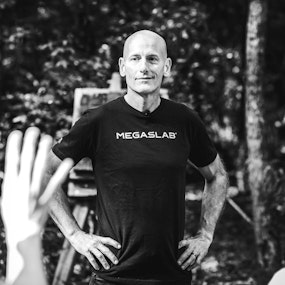
Jason Adams
Founder & CEO
Jason Adams is Founder & CEO of MEGASLAB®, a concrete technology company focused on making the strongest and most durable concrete possible all while addressing sustainability goals for some of the largest brands in the world.








